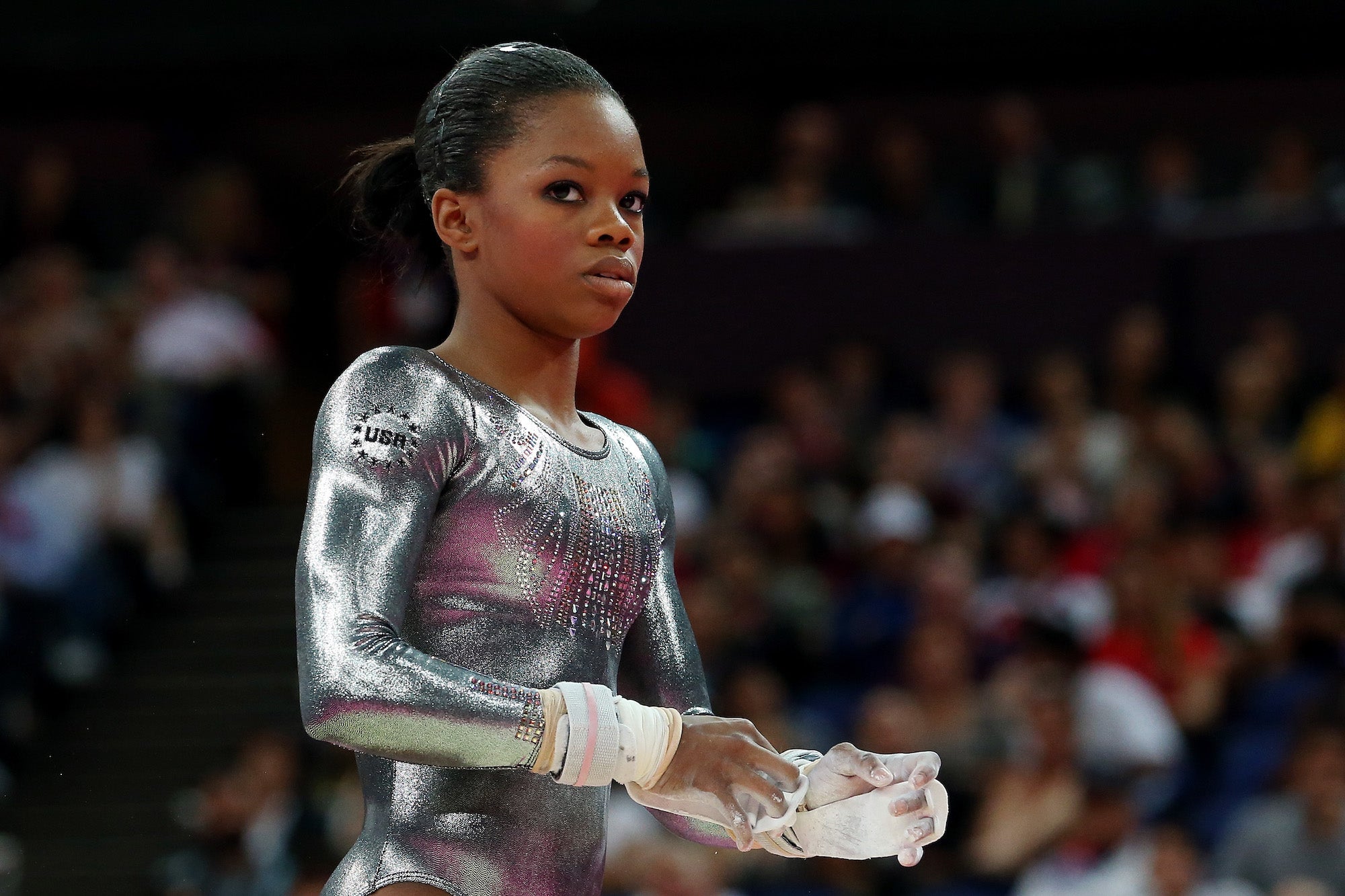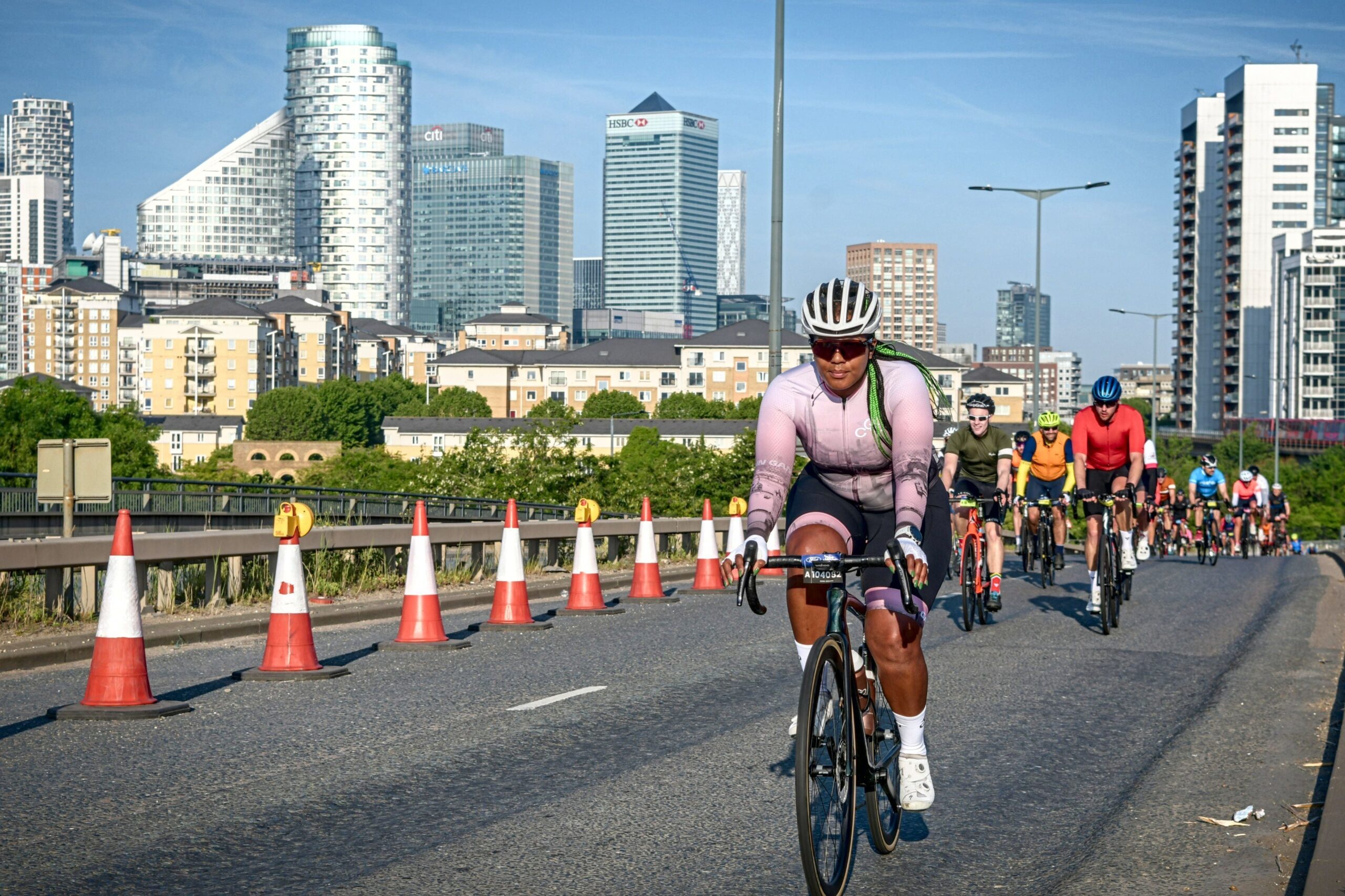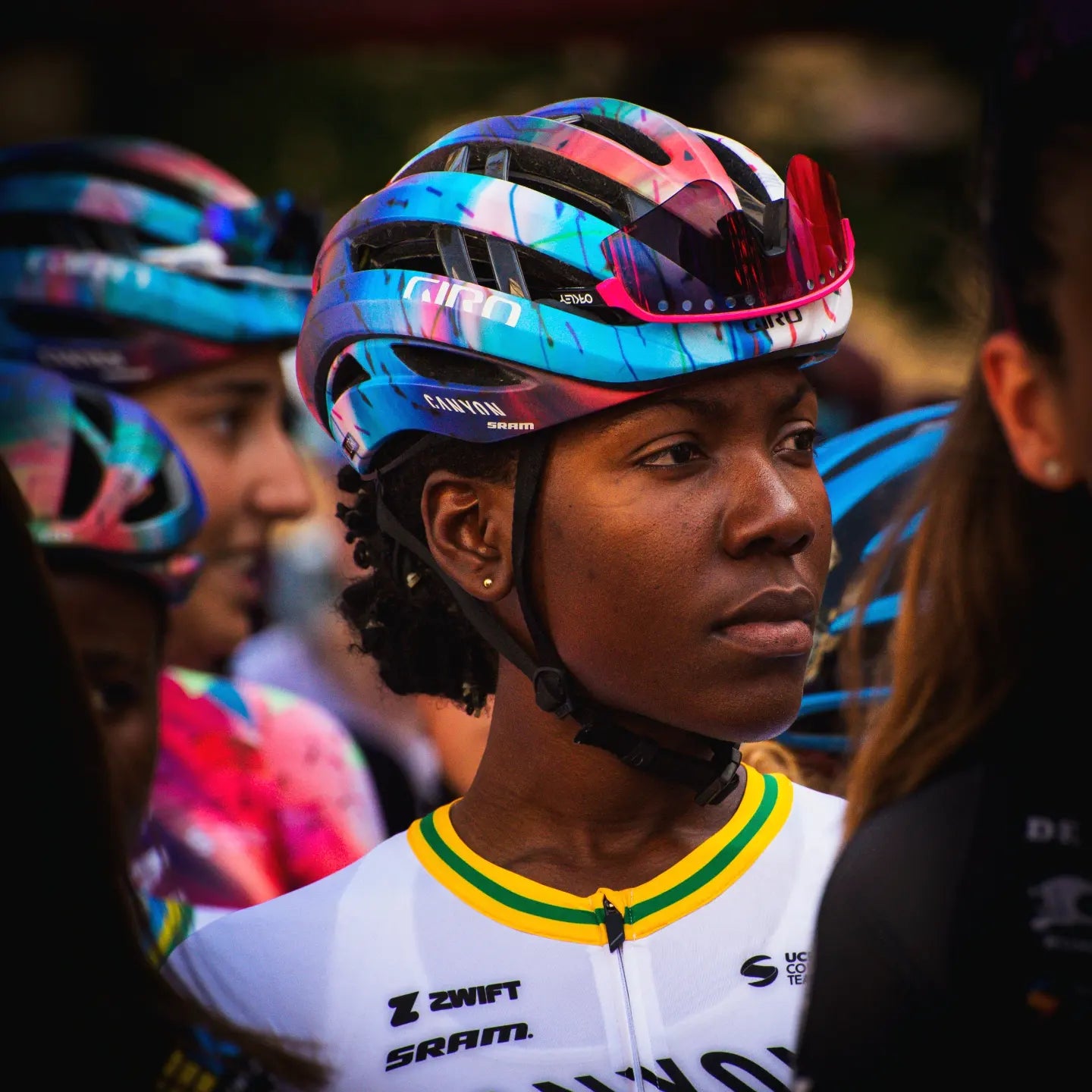Washing your hair is an easy task to many. Shampoo, rinse, conditioner, rinse, blow-dry, done. Three simple steps. Therefore, while it is annoying sometimes, washing your hair post getting sweaty, whether at the gym or after a ride, it is not a monumental task. This in turn makes people more likely to stick to a physical activity. However, this is not the same story for women with afro-textured hair. There are more steps, costly hair care products, and lengthy styling involved. And you often don’t find any products provided by gyms or sports centres for those with afro-textured hair, so it is not quite the same as one, two, three.
This plays such a big factor in a women’s routine that it was actually found that one in three Black women don’t participate in sport because of their hair compared to one in 10 White women (The ‘Good’ Hair Study, 2017). This is supported by the fact that Black women are the least active group because sport and fitness is not seen as accessible or attractive. Cycling, in particular, has another hurdle for women to overcome – the helmet. Finding a helmet to keep safe on the roads when having hair with a lot of volume is no easy task and can lead to both expensive and unsafe results. That not only leaves Black women out of the sport, but jeopardising their safety too.
Black hair is more than just hair, it has a deep-rooted connection to its heritage. Many women and men with afro-textured hair proudly celebrate their natural hair, viewing it as more than just a physical attribute. However, despite this positive shift, discrimination persists, even in the realm of sports where individuals showcase extraordinary feats of physical prowess. The ongoing hair-related challenges stand in stark contrast to the incredible accomplishments within the sporting arena, highlighting the persistence of this issue.
In a conversation with Rouleur, three female Black cyclists share insights into managing and maintaining their hair, and how they ensure it doesn’t hinder their enjoyment and participation in cycling.
Hair is heritage
The historical evolution of afro hair is deeply intertwined with cultural, societal, and political dynamics. It can be traced back to tribal Africa, where hair served as a means of defining roles, hierarchy, and status through various types of wigs and weaving. Then, during the era of slavery, afro hair was unjustly stigmatised, with individuals being told that their natural hair symbolised inferiority and was dehumanised.
After the abolishment of slavery, Annie Malone became the first African American woman to patent the hot comb, a heated comb to smooth out afro kinks, so people could have “good hair” like White women. Then, in 1909, the first chemical hair relaxer was also introduced. Since its inception, the hot comb and chemical relaxer have remained an essential hair styling tool for a number of women with afro-textured hair.
However, the 1960s marked the beginning of a natural hair movement within the Black community. Rejecting the negative perceptions associated with their hair, Black individuals reclaimed their natural textures as symbols of pride, power, and heritage, rather than indicators of status and inferiority. Icons like Diana Ross and the Jackson 5 embraced their natural hairstyles, contributing to the broader societal shift in perception.
The 1990s further propelled Black hair into mainstream media, with cultural phenomena like the TV show The Fresh Prince of Bel-Air and influential figures like Janet Jackson and Lauryn Hill gracing the cover of Time magazine. This period, often deemed the ‘golden era’ for Black culture in music, television and film, fostered a “cool” status for Black hair, encouraging Black women to wear their hair with pride.
Even in recent times, public figures like Michelle Obama, post-serving as First Lady, have contributed to celebrating natural Black hair. However, her acknowledgment of having refrained from displaying her natural hair during her husband’s time as US President underscores the challenges Black women still face in embracing their natural hair without encountering criticism.
 Black women in sport have had to deal with criticism and comments over their hair even when they’ve made history as Gabby Douglas did in 2012 (Ronald Martinez/Getty Images)
Black women in sport have had to deal with criticism and comments over their hair even when they’ve made history as Gabby Douglas did in 2012 (Ronald Martinez/Getty Images)
This is evident in sport also, where hair has become a battleground for acceptance. American Olympic gymnast Gabby Douglas was heavily criticised at the 2012 London Olympics, just aged 16, for not having laid her edges with wax or gel. She took to Instagram and said: “I made history and people are focused on my hair? It can be bald or short; it doesn’t matter about (my) hair.” Simone Biles, another exceptionally well-decorated gymnast, also faced severe criticism by the public because her hair was apparently “not done” in her wedding photos she posted on social media.
And it is not just individual, it is also institutional. For example, FINA (the governing body for aquatic sports) declined the application of the use of swim caps made by Soul Cap, a black-owned swim cap brand which is aimed at making swimming, where only two per cent of regular swimmers are Black, more inclusive and open to everyone. FINA argued that the caps did not “fit the natural form of the head”, sparking great debate around the lack of diversity in the sport. In 2022, FINA issued an apology and announced that Soul Caps could be used in competitive swimming at every level. While it’s a step forward for the sport of swimming, those with afro hair needed to fight for it.
“To me, when it comes to Black women and their hair it’s sort of like, ‘damned if you do, damned if you don’t,’ meaning that if you do wear your natural hair, it has to be styled certain ways or in a lot of cases, be of a certain texture to be deemed ‘acceptable’ or not really worth commenting on,” said Llori Sharpe, professional cyclist for Women’s WorldTour team Canyon//SRAM. “And if you don’t, some may say you’re insecure and want to cover up your hair because you’re ashamed.”
This was echoed by Donna McConnell, a 54-year-old woman who lives in London and fell in love with cycling after purchasing her first bike at the age of 18. “Black women are judged by a higher standard when it comes to appearances because we do stand out, there are differences between us,” she said. “Obviously, the first thing people notice about us is the colour of our skin. And the second thing is our hair.”
Maintaining healthy hair
Both Sharpe and McConnell are very active. Sharpe is a full-time professional cyclist and McConnell trains for triathlons. While neither of them have ever been put off from sport because of their hair, McConnell does recall moments in her life where she was more aware of hair. “There was a period where I had my hair relaxed, so I probably would have been more sensitive to it,” she said. McConnell also added that if she had had her hair freshly braided, she might abstain from going swimming for a week or so and will instead opt for other activities like cycling or running.
 Donna McConnell took part in the 2023 Ford Ride London sportive (Image by Ride London)
Donna McConnell took part in the 2023 Ford Ride London sportive (Image by Ride London)
Team GB track cyclist, Rhianna Parris-Smith, also found that her hair never put her off participating in any sport, but she did acknowledge that her hair became more prevalent when she started cycling due to having to wear a helmet and increased level of training.
Black women’s hair is particularly prone to a type of hair loss called traction alopecia which is caused by heat, chemicals and tight styles that pull at the hair root. Add in sweat and constant washing into that equation and those with afro-textured hair increase their chances of experiencing this type of hair loss, creating another factor which may deter women from physical exercise. A dedicated hair care routine is therefore vital for maintaining healthy hair and scalp. Something Sharpe, McConnell and Parris-Smith emphasised when speaking about their regimes post-exercise.
“I know all women will have unique experiences with their hair, but for me, it was just a matter of education on what my hair needed and the styles that kept it healthy,” Sharpe said. “And I for one can attest to dreading hair wash days. I simply did not want to deal with my hair as it can take up a lot of time, but I am now at a place where I no longer see my hair as burdensome and actually look forward to setting aside time to care for it now.”
For all three women, their love for sport outweighs the time it takes to wash, dry and style their hair. So, instead of having a hairstyle that requires a lot of upkeep and maintenance, they all mentioned that they use low-maintenance, protective hairstyles that are easy to manage. “For me, I usually go for twists or braids, either with my own hair or added hair, or a low bun. As long as I can access my scalp and I am able to cleanse it and moisturise my hair periodically, I’m good,” said Sharpe.
Parris-Smith said she opted for a straighter style. “I straighten my hair a lot more than I normally would, just for ease of training six days a week. I will straighten my hair once a week, maybe once every two weeks, and that sorts it for training. That’s the way I have found the easiest to manage.”
“Sometimes I will have two braids, but it lasts a shorter length of time,” added McConnell. However, sometimes her chosen hairstyles adds a layer of complexity that is unwarranted. “I like the nice colours you can have too. The only thing I would say is that it really attracts a lot of people who are curious about my hair or wanting to touch it. I actually had locs [dreadlocks] for 20 plus years and a lot of people would ask if they could touch them. I’ve had it since I was a kid and it is just a bit tiring. You know, I don’t want to be touched. It makes me feel odd and a bit invaded. I find it a bit disappointing.”
A question of safety
One thing that makes cycling different from sports such as running and swimming is the helmet. Participants like Sharpe, Parris-Smith, and McConnell, who have engaged in various sports, highlight the unique considerations associated with cycling helmets.
McConnell mentioned taking her helmet to the hair stylist, so she can accommodate numerous plaits without compromising the fit. She also said she owns helmets in different sizes to cater to diverse styling preferences, such as a bulkier look or a style with more volume. However, investing in multiple helmets can be a considerable financial commitment, especially considering the average cost of a performance road cycling helmet, which hovers around £150.
 Llori Sharpe is a professional rider for Women’s WorldTour team Canyon//SRAM (Image by Beth Duryea)
Llori Sharpe is a professional rider for Women’s WorldTour team Canyon//SRAM (Image by Beth Duryea)
Some people get a new helmet and remove the cage-like structure inside, she said, most often the helmet’s Mips safety technology. “That is the first thing to go if you’ve got lots of hair,” McConnell added. But stripping away these safety features leaves riders exposed to risks during falls or accidents. As the cycling community strives for greater inclusivity, there is a growing need for brands to consider the diverse needs of individuals from different backgrounds with people still feel their needs are being ignored. “A helmet brand has probably never considered the different types of hair that exist within the world,” McConnell added.
When Kask, a leading helmet manufacturer in the cycling industry, was asked about the options of helmets available to those with afro-textured hair, the Italian brand confirmed it did not yet have a dedicated helmet for those with more voluminous hair. It added that it did “not exclude the possibility of moving in that direction in the future”, but in the meantime, recommends trying different helmet sizes and models to find the best fit and ensure safety.
“I don’t think they’re [brands] intentionally putting that barrier there,” said Sharpe. “I think it’s just them being stuck in what they know and what the cycling community has been for so many years. It’s just a matter of them opening up to them opportunities to be more inclusive, essentially.”
In a world where maintaining afro-textured hair can become a factor for participation, the stories of athletes like Llori Sharpe, Donna McConnell, and Rhianna Parris-Smith clearly demonstrate how they are not letting societal factors impact their love for sport. Women who want to participate in sport can have a healthy relationship with their hair. But inclusivity and consideration for those with afro-textured hair still needs to be moved forward.
The ‘Good’ Hair Study’s revelation that one in three Black women abstain from sports due to hair concerns is a wake-up call. More must be done to target these women who miss out on the enjoyment and benefits of sport, whether this is through hair products being provided in sports centres, brands catering to diverse needs, or more women like Sharpe, McConnell and Parris-Smith demonstrating that hair doesn’t have to stop you from doing something you love.
Let’s turn the page on exclusion and embrace a sporting world where every hair type is not just accepted, but celebrated.
*Cover image by SWPix.com
This post was originally published on this site be sure to check out more of their content.






